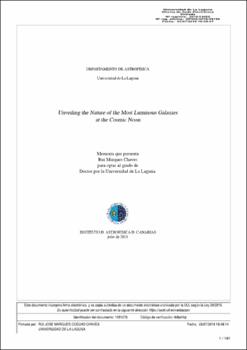Unveiling the nature of the most luminous galaxies at the cosmic noon.
Fecha
2018Resumen
This thesis focus on understanding the physical properties of galaxies at redshifts 2.3 < z < 3.3, a time period called Cosmic Noon when galaxies were actively forming stars and evolving rapidly. The work involves the study of different galaxy populations, from young Lyα emitters (LAEs) and Lyman break galaxies (LBGs), to more evolved, and very actively star forming submillimeter galaxies (SMGs) detected with the Herschel Space Observatory. Because of the faintness of these high redshift galaxies, this work employ the power of the gravitational lens effect in high signal-to-noise (S/N) studies to probe deeply into their physical properties in a multi-wavelength approach, with particular emphasis to the rest-frame ultra-violet (UV) emission.
First, the BELLS GALLERY project is presented, a dedicated survey aimed to search for strong gravitationally lensed systems with 2 < z < 3 LAEs as background sources. Within this project, the thesis work reports the discovery of two very bright lensed LAEs, that are within the brightest and intrinsically most luminous LAEs known so far at any redshift. In addition, results from a deep optical imaging and spectroscopic survey with the Gran Telescopio Canarias and the William Herschel Telescope targeting six of this new type of strong galaxy-scale lensed LAEs are described and discussed. The main properties of these lensed LAEs are derived, such as their Lyα and UV luminosities, star formation rates, and dust attenuation. Several rest-frame UV diagnostics are also employed on their high S/N spectra to study the kinematics of the interstellar medium and the observed spatial distribution of the UV continuum and Lyα emission.
Second, a detailed imaging and spectroscopic analysis of one of the brightest gravitationally lensed SMG, HLock01 at z = 2.96, is presented. It is shown that HLock01 is a merger system composed of a massive Herschel-selected SMG and an optically bright, satellite LBG, separated by only 3.3 kpc in projection. The high S/N rest-frame UV spectrum of the LBG also shows evidence of large scale gas motions, including gas outflows from the LBG, inflowing gas falling onto the Herschel SMG, and an extended reservoir of neutral gas at an impact parameter of 110 kpc. These results are one of the first observational confirmation that gas accretion, along with on-going mergers, are the main mechanisms responsible for the extremely large star formation rates seen in many SMGs.
Lastly, the serendipitous discovery of a large, extended Lyα nebula at z = 3.325 is presented. The nebula shows Lyα emission extended over 110 kpc with a total luminosity L(Lyα) = (6.00±0.08)×10^44 erg s^(-1) , being one of the most luminous Lyα nebula known so far. It also shows extended emission of C IV, He II, and C III] over ~ 90, 50, and 35 kpc, respectively. The origin of this nebula is likely associated with a massive type 2 active galaxy and the two faint radio lobes or jets contained within its central ~ 8 kpc.





